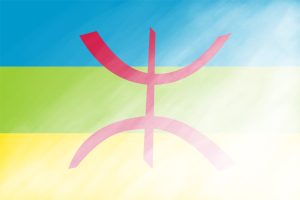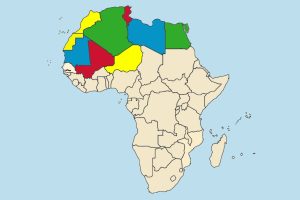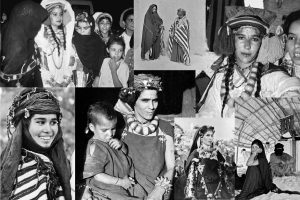Postcard 1: Erasure of Amazigh Flag

This postcard is a representation of the Amazigh flag. It is a flag that has been adopted by many Amazigh populations, as well as protestors and cultural and political activists. Each color of the flag corresponds to an aspect of Tamazgha, which is the indigenous name for the territory in North Africa that is inhabited by the Amazigh people. The blue represents the Atlantic Ocean and the Mediterranean Sea, the green represents Tamazgha, the yellow represents the desert, and the red emblem “Yaz” represents a free man, which is also the meaning of the word “amazigh.” Together, the flag symbolizes the entire Amazigh people, living in harmony with their land, and it represents Amazigh pride.
In 2019, after peaceful protests in Algeria that were centered around fighting the attempted erasure of the Amazigh language and cultural identity, 41 people were arrested for simply carrying the Amazigh flag, stating it was an assault on Algeria’s Arab identity. Those arrested were charged with “harming the integrity” of the country, and if charged could have faced up to 10 years in prison and a fine of 3,000-70,000 Algerian dinars. Many people criticized the Algerian authorities, stating that their actions were a blatant attack on the rights to freedom of expression and peaceful assembly of the Amazigh community.
For centuries, the Amazigh language and cultural identity have been ignored and erased by the governments of the nations in which they live. My postcard is meant to symbolize the attempted erasure of the Amazigh flag, highlighting their fight for cultural recognition and independence.
Sources:
Hmouri, Said. “The Three Fundamental Principles of Amazigh Identity.” Home, May 19, 2021. https://amazighworldnews.com/the-three-fundamental-principles-of-amazigh-identity/.
“Algeria Wave of Arrests of Protesters Carrying Amazigh Flag.” Amnesty International, August 13, 2021.https://www.amnesty.org/en/latest/news/2019/07/algeria-41-arrested-for-carrying-the-amazigh-flag-as-authorities-crack-down-on-freedom-of-expression/.
Postcard 2: Map of North Africa w/ Colors of Amazigh Flag

Crucial to the culture of North Africa, the Amazigh have been in a state of resistance or compromise with one power or another for thousands of years. There are more than 30 million Amazigh people currently living throughout the Maghreb Region, which they call Tamazgha, stretching from the Siwa Oasis in Egypt to the Canary Islands, and from the Mediterranean Sea to the Niger and Senegal Rivers. This covers a territory that is over 7 million square kilometers, which means that if Tamazgha were a unified country, it would be the 7th largest on earth. The Amazigh predominantly live in the countries of Morocco, Algeria, Tunisia, Libya, Egypt, Mali, Niger, and Mauritania, and their unique culture and language distinguish them from their Arab neighbors, yet their ethnic and cultural identities continue to be contested.
In order to reinforce the Amazigh movement and their fight for language recognition and cultural rights, I used the four colors of the Amazigh flag to highlight the nations across the Maghreb Region in which the majority of the Amazigh people live. As the governments of many of these countries attempt to erase the language and ethnocultural identity of the Amazigh people, I want this map to serve as a reinforcement of their existence and a recognition of their fight for cultural liberties and freedoms.
Postcard 3: Amazigh Women

Photos From: “Amazigh Arts in Morocco: Women Shaping Berber Identity,” by Cynthia J. Becker
As public symbols of Amazigh identity, Amazigh women play extremely influential roles in their society, and they are a powerful force in the movement for their ethnocultural and ethnolinguistic recognition. However, Amazigh women have been misrepresented or erased in many past forms of academic discourse, and are often left out of conversations centering around Amazigh activism.
The position of Amazigh women in their communities demonstrates the complexity of gender roles and how the binary categories often used to describe traditional roles tend to oversimplify gender relations in Muslim and North African cultures. Considered as central to the recognition of Amazigh ethnic identity, Amazigh women play an extremely important role in the arts, economies, and cultures of the communities in which they live. The importance of the women in their communities defies common stereotypes and generalizations about women in the Muslim world that exist within past and present discourse, such as the idea that men economically support women, and the notion that women in Muslim societies are associated with the inner, domestic world, while men are associated with the outer, public world. However, it is Amazigh women and the labor they produce that are essential to the financial well-being of their families. They are also responsible for maintaining artistic symbols of Amazigh ethnic identity, contributing to music, clothing, and art, and upholding and creating new traditions and Amazigh pride.
With this postcard, I wanted to highlight Amazigh women. I used photographs from Cynthia J. Becker’s book, Amazigh Arts in Morocco: Women Shaping Berber Identity, to put them in the spotlight, as they have often been ignored or forgotten from academic discourse surrounding the Amazigh movement. These photographs represent Amazigh women in the many different aspects of their lives. From traditional wedding ceremonies to their role as mothers and artists, they showcase the diversity of the women throughout the region, and highlight their significance in Amazigh communities.
Sources:
Cynthia J. Becker, Amazigh Arts in Morocco: Women Shaping Berber Identity (Austin, Tex: University of Texas Press, 2010), 42-173.
